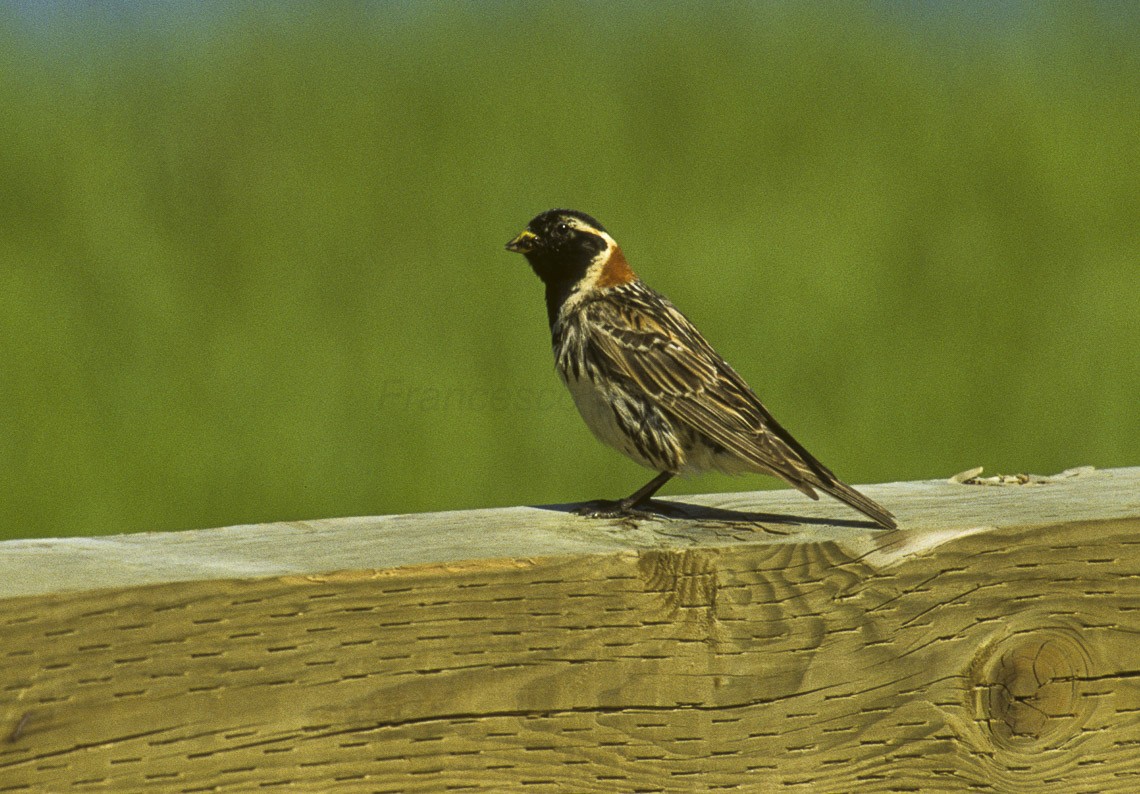Lapland Longspur
A species of Longspurs Scientific name : Calcarius lapponicus Genus : Longspurs
Lapland Longspur, A species of Longspurs
Botanical name: Calcarius lapponicus
Genus: Longspurs
Content
Description People often ask General Info
 Photo By Francesco Veronesi , used under CC-BY-SA-2.0 /Cropped and compressed from original
Photo By Francesco Veronesi , used under CC-BY-SA-2.0 /Cropped and compressed from original Description
The Lapland longspur is a robust bird, with a thick yellow seed-eater's bill. The summer male has a black head and throat, white eyestripe, chestnut nape, white underparts, and a heavily streaked black-grey back. Other plumages have a plainer orange-brown head, a browner back and chestnut nape and wing panels. Measurements: Length: 5.9-6.3 in (15-16 cm) Weight: 0.8-1.2 oz (22.3-33.1 g) Wingspan: 8.7-11.4 in (22-29 cm) 
Size
15-18 cm (6-7 in)
Colors
Brown
Black
Red
Bronze
Gray
White
Orange
Life Expectancy
6 years
Nest Placement
Ground
Clutch Size
3 - 7 eggs
Incubation Period
1 brood
Number of Broods
11 - 13 days
Nestling Period
6 - 10 days
Feeding Habits
Lapland Longspur's diet varies seasonally, consisting predominantly of seeds, such as grass, foxtail, and wheat, in winter. During summer, lapland Longspur transitions to arthropods, mainly dipteran larvae and adults, catching them mid-air or foraging through vegetation. Nestlings receive only arthropods. Lapland Longspur forages on the ground or snow surface, consuming up to 10,000 items daily.
Habitat
Lapland Longspur thrives in open, treeless landscapes, particularly the arctic tundra during breeding seasons and high-elevation alpine tundra in Alaska's mountain ranges. Preferring areas with minimal vegetation, lapland Longspur is adapted to cold climates with short grass or bare ground. Outside the breeding season, lapland Longspur inhabits open habitats including grasslands and steppes, tolerating a range of altitudes from coastal areas to mountainous regions.
Nest Behavior
Lapland Longspur typically constructs its nest in spring, with egg-laying following soon after. Parental care includes incubation and feeding, shared responsively by both parents, ensuring chick survival in their Arctic breeding grounds.
Nest Characteristics
Lapland Longspur's nest is a concealed, tightly woven cup of grasses, located in a hollow on the ground, usually in a wet meadow at the base of a tussock with overhanging vegetation. It's lined with ptarmigan feathers or mammalian fur.
Dite type
Insectivorous
People often ask
General Info
Feeding Habits
Bird food type
Sounds
Call
Recording location: United States
Song
Recording location: United States
Song
Recording location: United States
Behavior
Lapland Longspur demonstrate a dynamic blend of solitary and social behaviors throughout the year. In their arctic breeding grounds, male lapland Longspur claim territories where they woo potential mates with an elaborate flight song display, gliding to the ground from significant heights while singing. This display, paired with the 'Grass Display' where they present gathered grasses and moss to females, is pivotal in their mating ritual. Outside the breeding season, lapland Longspur become highly sociable, forming immense, interspecies flocks often seen alongside Snow Buntings and Horned Larks. Their daily activities fluctuate seasonally, from solitary territory defense to participating in large, communal gatherings in winter.
Distribution Area
It breeds across Arctic Europe and the Palearctic and in Canada and the northernmost United States. It is migratory, wintering in the Russian steppes, the southern United States, Northern Scandinavian arctic areas and down to coastal Southern Sweden, Denmark and Great Britain. This is the only Asian species of the longspur buntings, and while it probably did not evolve there, it has been present in Eastern Europe for at least about 30,000 years. 
Species Status
Not globally threatened.
Scientific Classification
Phylum
Chordates Class
Birds Order
Perching birds Family
Longspurs and snow buntings Genus
Longspurs Species
Lapland Longspur